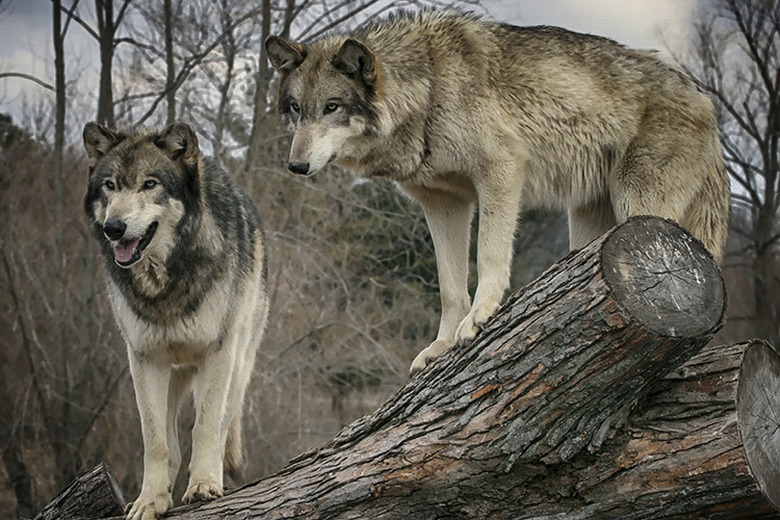Pack Behaviors Of Wolves Vs. Dogs
Fido and Fluffy might not have to hunt for their dinner like their wild cousins, but domestic dogs do display certain pack behaviors, just like wolves. If you're part of a canine pack, recognizing these behaviors can help you understand your pampered pooch.
NOTE: "Dominance Theory" is a widely debated topic among dog behaviorists, but we at Cuteness like to give voice to writers on both sides of the debate. For an opposing view, please see our article Social Hierarchy Among Dogs.
Social Structure in Wolves
In the wild, it's crucial to the survival of the pack that there's a strong, recognized leader. This wolf is referred to as the alpha, and a pack is usually made up of an unrelated alpha breeding pair and their offspring and extended family. By operating in cohesive packs, wolves are more successful in hunting and protecting the pack from danger. A clear social and linear dominance hierarchy helps maintain order and conserve energy. Dominant animals eat first, get first choice of mates and are responsible for deciding when to hunt and which direction to travel.
Social Structure in Dogs
Dogs have been selectively bred for thousands of years to be social, playful, less fearful and less aggressive (specifically toward humans) than wild canines. The domestic dog's best chance of survival is to stay near humans. If the dog sees his humans as his pack, linear dominance is not necessary because there is no need to hunt. Still, in multi-dog households, most people can see that dogs maintain a type of social order amongst other dogs. Domestic dogs are similar to wolves in this respect — and the group dynamic is maintained until members join or leave. Should conflicts arise, dogs appear to sort out any differences on a case-by-case basis and exist peacefully. An article published by the Association of Professional Dog Trainers states: "the status of one dog over another is fluid; in other words, one dog may be the first to take his pick of toys, but will defer to the other dog with it comes to choice of resting places." Therefore, unlike wolf packs, domestic dogs have no "alpha" who is clearly dominant in all situations.
Communication within a Wolf Pack
Wolves communicate in three ways — olfactory, body language and vocally. Wolves use scent from urine and from glands on their paws to mark pack territory and ownership of food resources. Dominance in the pack is indicated by certain body language, such as bared teeth and ears pointed forward, and slit eyes and ears back indicate subordinate behavior. Tail positions also indicate dominance or submission — high and perpendicular signal dominance, while a tucked tail indicates submission.
Vocally, wolves howl, whine, growl and bark. Howling is generally thought to be a means of assembling the pack or to claim territory. Growling is considered an aggressive vocalization used by dominant wolves in the pack toward submissive individuals. Barking can indicate alarm, a call to hunt or excitement in general.
Communication within the Dog Pack
Most of the behaviors that dogs share with wolves have to do with communication. Like wolves, dogs use olfactory, body language and vocalizations to communicate. Unlike wolves, dogs have also evolved ways to communicate with humans, ways they don't display to communicate with each other. This indicates that, like the wolf, the dog is hard-wired to live in social groups — packs. Dogs use scent to mark territory and to announce "I've been here," and most people can tell the difference in body language between a friendly dog and a threatening dog — bared teeth and tail-wagging are examples of how dogs communicate with their packs.
Dogs use vocalizations primarily to communicate with humans and not other dogs. For instance, they will bark excitedly to get you to open the door. They howl to attract attention or announce their presence, and some will howl in response to sirens or other high-pitched sounds. Humans can translate some of these vocalizations. On the other hand, even an average dog will likely learn dozens of human words over his lifetime.
By Leslie Darling
References
ADPT: Dominance and Dog Training
Pet Place.com: Canine Social Structure
Italian">www.italian-greyhound.net/packbehave.htm"">Italian Greyhound.net: Understanding Pack Behavior
Wolf Haven: Communication and Behavior
Pet Place.com: Dog-Human Communication
About the Author
Leslie Darling has been a writer since 2003, writing regularly for "Mississippi Magazine" and "South Mississippi Living," specializing in food and wine, animals and pets, and all things Southern. She is a graduate of the University of New Orleans.
